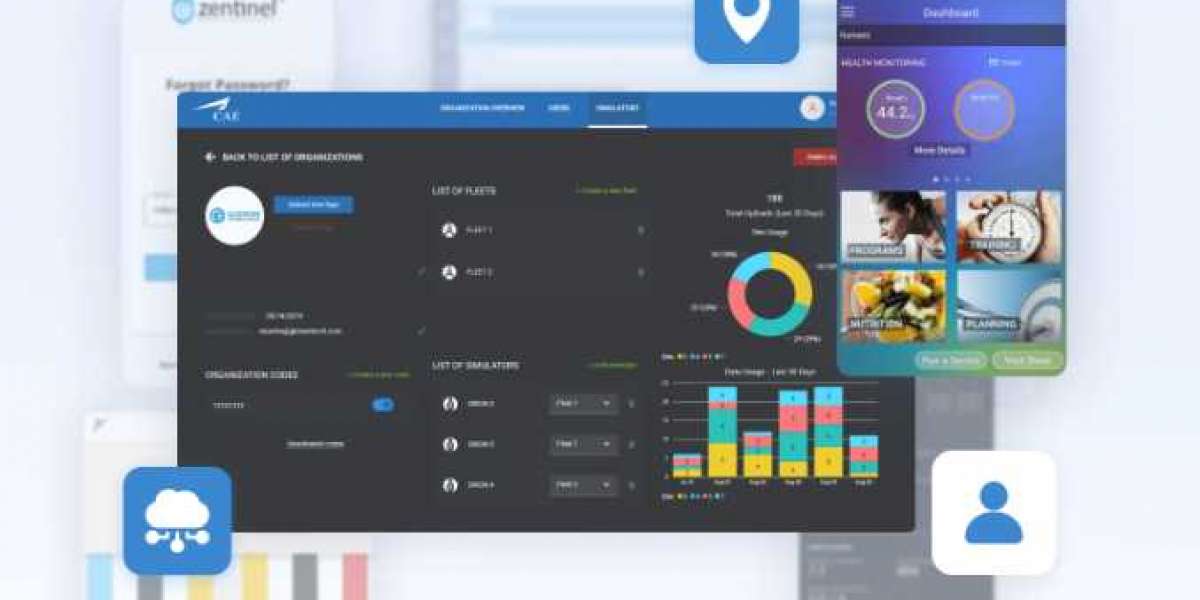Among these advancements, patient portal development stands out as a key innovation that is reshaping the way patients interact with their healthcare providers. A patient portal is a secure online platform that allows patients to access their health information, communicate with healthcare professionals, schedule appointments, and manage their care.
As healthcare moves towards a more patient-centric approach, the development of patient portals has become essential for improving patient engagement, streamlining administrative processes, and enhancing the overall efficiency of healthcare delivery.
In this article, we will explore patient portal development in depth, covering the following topics:
- What is a Patient Portal?
- Benefits of Patient Portal Development
- Key Features of a Patient Portal
- Challenges in Developing a Patient Portal
- Best Practices for Patient Portal Development
- Patient Portal Security and Compliance
- The Future of Patient Portals
1. What is a Patient Portal?
A patient portal is an online system that gives patients secure access to their personal health information (PHI) and facilitates interaction with healthcare providers. These portals are typically integrated with electronic health record (EHR) systems, ensuring that the data shared is up-to-date and accurate. Patients can log in to view their medical records, lab results, and medications, as well as communicate with their healthcare team.
Patient portals are designed to empower patients by giving them greater control over their healthcare journey. They can be used to monitor chronic conditions, request prescription refills, pay medical bills, and receive educational resources on maintaining a healthy lifestyle. The accessibility of health information through portals has become increasingly important, particularly in the wake of the COVID-19 pandemic, as it reduces the need for physical visits and enhances virtual care.
2. Benefits of Patient Portal Development
Patient portal development offers a wide range of benefits, not only for patients but also for healthcare providers and administrators. These benefits include:
a) Improved Patient Engagement
One of the primary benefits of patient portals is improved patient engagement. Patients who have easy access to their medical records are more likely to take an active role in managing their health. They can monitor their test results, track changes in their conditions, and communicate with their doctors, which fosters a collaborative approach to care.
b) Enhanced Communication
Portals provide a convenient way for patients to communicate with healthcare providers without the need for phone calls or in-person visits. Secure messaging features allow patients to ask questions, clarify medication instructions, or request advice from their doctors at any time. This real-time communication improves patient satisfaction and can lead to better health outcomes.
c) Increased Efficiency in Administrative Processes
Patient portals can automate a number of administrative tasks, such as appointment scheduling, prescription refill requests, and bill payments. This reduces the burden on office staff, allowing them to focus on more critical tasks, such as patient care. Automating these processes also reduces errors that can occur in manual entry, leading to more accurate scheduling and billing.
d) Cost Savings
By reducing the need for phone calls, paper forms, and in-person visits, patient portals can save healthcare providers significant amounts of time and money. Patients can complete pre-visit forms, check-in remotely, and access health education materials online, reducing the need for physical resources. Additionally, fewer missed appointments, thanks to automated reminders through the portal, can lead to improved revenue cycles for healthcare organizations.
e) Better Access to Health Information
Patient portals ensure that patients have access to their health data whenever they need it. This accessibility is especially beneficial for patients managing chronic conditions, as it allows them to track their progress, review medication details, and stay informed about their care plans. By having access to this information, patients can make informed decisions about their treatment and discuss options with their healthcare providers.
f) Support for Telemedicine and Remote Care
Telemedicine has become an essential component of healthcare delivery, particularly during the pandemic. Patient portals play a crucial role in supporting telemedicine by allowing patients to schedule and participate in virtual appointments, share health data with their providers, and receive follow-up care from the comfort of their homes. The integration of telehealth services with patient portals improves the continuity of care and reduces barriers to accessing medical services.
3. Key Features of a Patient Portal
The success of patient portal development hinges on the inclusion of essential features that meet both patient and provider needs. The following are key features that should be considered in any patient portal development project:
a) Secure Login and Authentication
Since patient portals contain sensitive health information, security is paramount. A secure login system that requires multi-factor authentication (MFA) is essential to ensure that only authorized individuals can access the portal. Encryption of data both at rest and in transit further enhances the security of the platform.
b) Access to Medical Records
Patients should be able to view their medical history, including lab results, imaging reports, diagnoses, and treatment plans. The information should be presented in a user-friendly manner, with explanations or links to educational resources where necessary. Additionally, patients should have the ability to download or print their records for personal use or to share with other healthcare providers.
c) Appointment Scheduling
The ability to schedule, reschedule, or cancel appointments online is a must-have feature for any patient portal. This functionality should include options to view available time slots, receive reminders, and choose between in-person and virtual visits. Offering a user-friendly interface for appointment scheduling enhances the convenience of the portal and reduces the likelihood of missed appointments.
d) Secure Messaging
Secure messaging enables patients to communicate directly with their healthcare providers. This feature should support HIPAA-compliant messaging, allowing patients to ask questions, share concerns, or provide updates on their conditions without compromising the confidentiality of their health data.
e) Prescription Management
Patients should be able to view their current prescriptions, request refills, and receive notifications when it is time to renew a medication. Integration with pharmacy systems can streamline the refill process and ensure that patients receive their medications on time.
f) Bill Payment and Insurance Information
Patient portals should provide patients with a way to view their outstanding balances, make payments online, and review their insurance coverage. This feature simplifies the billing process for both patients and providers and reduces the need for paper statements or phone calls.
g) Health Education Resources
Providing access to educational resources, such as articles, videos, and tutorials, can help patients better understand their conditions and treatments. Personalized educational content based on a patient's health history can improve adherence to treatment plans and support long-term wellness goals.
h) Telehealth Integration
As telemedicine continues to grow, integrating telehealth capabilities into the patient portal is essential. Patients should be able to schedule and join virtual appointments directly from the portal, share health data with their providers, and receive post-visit summaries.
4. Challenges in Developing a Patient Portal
While patient portals offer numerous benefits, developing one is not without its challenges. Some of the key challenges include:
a) User Adoption and Engagement
One of the biggest challenges in patient portal development is encouraging users to adopt the technology. Some patients may be hesitant to use online systems due to lack of technical knowledge, privacy concerns, or resistance to change. Healthcare organizations must implement strategies to promote the portal's value and provide support for patients who need assistance using the platform.
b) Data Security and Privacy
Given the sensitive nature of health information, ensuring the security and privacy of patient data is critical. Developers must adhere to strict regulatory standards, such as HIPAA in the United States, to protect patient data from breaches or unauthorized access. Encryption, secure authentication methods, and regular security audits are necessary to maintain the integrity of the system.
c) Integration with Existing Systems
Patient portals must be integrated with existing EHR and practice management systems to provide real-time access to patient data. Achieving seamless integration can be challenging, particularly if the healthcare organization uses legacy systems or has multiple systems in place. Proper planning and collaboration with IT departments are essential to ensure successful integration.
d) Customization and Scalability
Healthcare organizations vary in size, specialties, and patient populations, so a one-size-fits-all solution is rarely effective. Developers must ensure that patient portals can be customized to meet the specific needs of the organization and can scale as the organization grows or changes. Customization options should include branding, workflows, and feature sets tailored to the organization's requirements.
e) Compliance with Regulatory Requirements
Patient portals must comply with regulations, such as HIPAA, the GDPR (General Data Protection Regulation), and other local laws related to patient data. Ensuring compliance requires a deep understanding of these regulations and the implementation of appropriate security measures, consent management, and audit trails.
5. Best Practices for Patient Portal Development
To ensure the successful development and implementation of a patient portal, healthcare organizations should follow best practices that focus on user experience, security, and functionality. Key best practices include:
a) Prioritize User-Friendly Design
The success of a patient portal depends on its ease of use. A user-friendly interface with intuitive navigation ensures that patients can access the portal's features without frustration. Developers should conduct usability testing to identify potential issues and make improvements based on patient feedback.
b) Offer Mobile Accessibility
In today's mobile-first world, patient portals must be accessible on smartphones and tablets. Offering a mobile-friendly design or a dedicated app ensures that patients can access their health information on the go. Mobile accessibility is particularly important for patients who rely on telehealth services or need to manage their health while traveling.
c) Provide Training and Support
For many patients, using a patient portal may be a new experience. Healthcare organizations should provide training and support to help patients navigate the system. Offering tutorials, FAQs, and a dedicated help desk can reduce frustration and increase user adoption.
d) Implement Security Best Practices
To protect patient data, developers must implement robust security measures. These include multi-factor authentication, data encryption, secure messaging, and regular security audits. Compliance with healthcare regulations, such as HIPAA, is also essential to avoid legal and financial penalties.
e) Integrate with EHR and Other Systems
To provide real-time access to patient information, the portal must be integrated with the organization's EHR system. Integration with other systems, such as pharmacy or billing systems, further enhances the portal's functionality and ensures that patients can manage all aspects of their care in one place.
6. Patient Portal Security and Compliance
Data security and compliance are critical aspects of patient portal development, given the sensitive nature of personal health information. Developers must ensure that the portal meets the following security and compliance requirements:
a) HIPAA Compliance
In the United States, patient portals must comply with the Health Insurance Portability and Accountability Act (HIPAA). HIPAA sets strict standards for the protection of electronic health information, requiring healthcare providers to implement administrative, physical, and technical safeguards to ensure data confidentiality, integrity, and availability.
b) Data Encryption
Patient portals must use encryption to protect sensitive information both in transit and at rest. This ensures that even if data is intercepted, it cannot be read or accessed by unauthorized parties.
c) Secure Authentication
Multi-factor authentication (MFA) should be implemented to ensure that only authorized individuals can access the portal. This adds an extra layer of security by requiring users to verify their identity through a secondary method, such as a phone number or email.
d) Regular Security Audits
To maintain the security of the portal, regular security audits should be conducted to identify vulnerabilities and address them before they can be exploited. Audits help ensure that the portal remains compliant with regulatory standards and that security protocols are up to date.
7. The Future of Patient Portals
As healthcare continues to evolve, patient portals are expected to play an increasingly important role in enhancing patient engagement and improving healthcare outcomes. The future of patient portals may include:
a) Artificial Intelligence and Machine Learning
AI and machine learning can be integrated into patient portals to provide personalized health recommendations, predict patient needs, and automate administrative tasks. These technologies can help identify patterns in patient data and offer insights to both patients and providers, leading to more proactive care management.
b) Expanded Telehealth Integration
Telehealth services are expected to become even more integrated with patient portals, offering patients a seamless experience when accessing virtual care. Features such as real-time video consultations, remote monitoring, and AI-driven chatbots may become standard components of future patient portals.
c) Improved Interoperability
Efforts to improve the interoperability of healthcare systems are likely to enhance patient portal functionality. Seamless data sharing between healthcare providers, labs, pharmacies, and other entities will enable patients to manage their health more effectively and ensure that all relevant parties have access to up-to-date information.
d) Enhanced Patient Education and Wellness Tools
Future patient portals may include more sophisticated wellness tools, such as personalized fitness plans, mental health resources, and nutrition guidance. By providing patients with access to these resources, healthcare organizations can promote preventive care and long-term wellness.
Conclusion
Patient portal development is revolutionizing the healthcare industry by providing patients with greater access to their health information and enhancing communication with healthcare providers. These platforms not only improve patient engagement but also streamline administrative processes, reduce costs, and support telemedicine and remote care.
However, developing a successful patient portal requires careful consideration of key features, security measures, and regulatory compliance. By following best practices and addressing challenges such as user adoption and data integration, healthcare organizations can create patient portals that deliver value to both patients and providers.
As technology continues to evolve, patient portals will likely play an even more significant role in healthcare, offering new opportunities for personalized care, improved patient outcomes.







